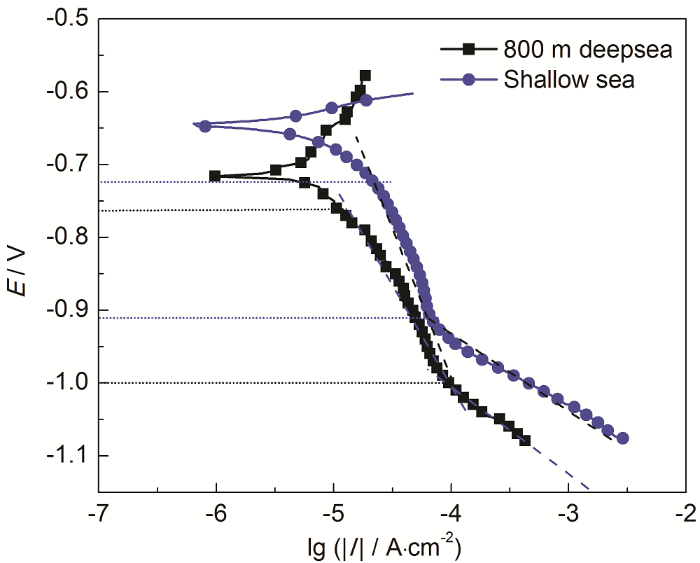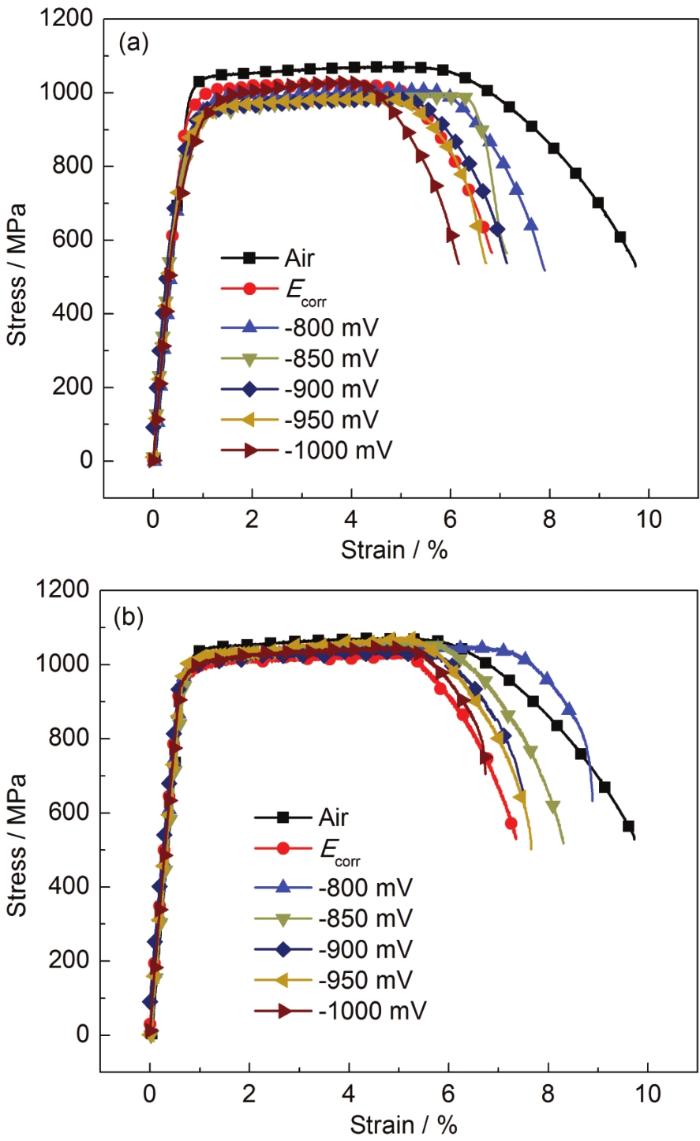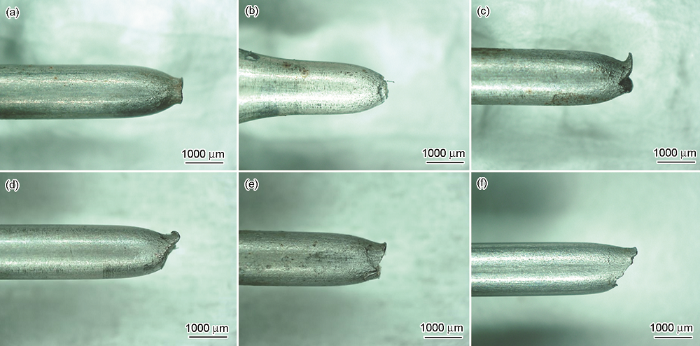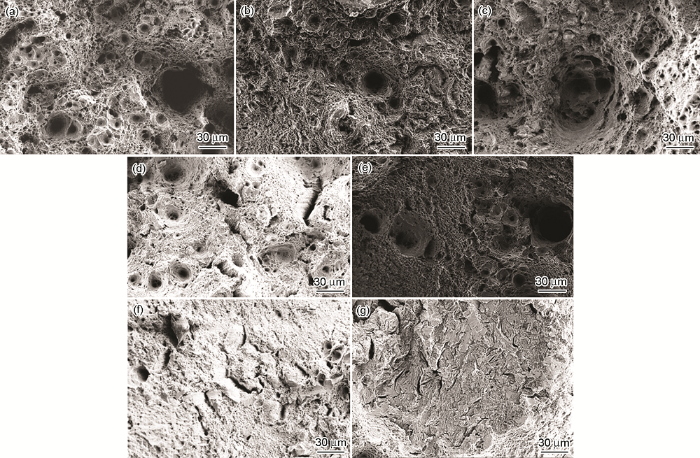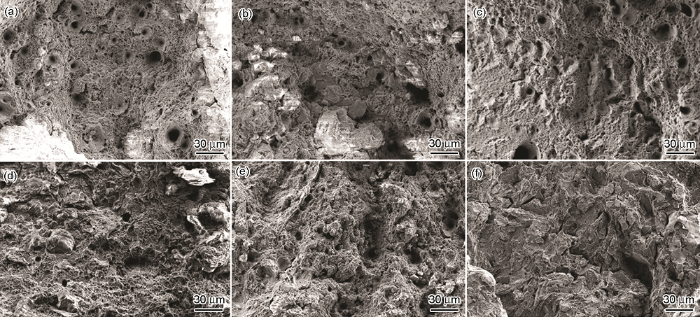近年来,发展海洋经济和海洋科技已经被我国提升到前所未有的战略高度,海岸工程、海洋开采、水下工程等战略性新兴海洋产业正在迅速兴起,在开展近海海洋工程建设的同时,设施也不断在向远海和深海拓展[1]。海洋环境对金属的腐蚀非常严重,而深海环境的光照、温度、压力、溶解氧、pH值、含盐量、海水流速及生物环境等因素与表层海水环境不同,因而具有其独特的环境特性[2-5]。高强钢作为大量应用于深海环境的仪器设备和海工装备的金属材料,为了减缓其在深海环境中的腐蚀,延长其使用寿命,需要对其进行腐蚀防护。海洋工程装备设施通常采用阴极保护的方法来进行防护[6,7]。而高强钢由于其自身的强度高、具有位错和夹杂等组织缺陷的特点,在阴极极化电位过负时容易发生阴极析氢从而导致氢脆的危险,因此在对其施加阴极保护时需要确定合理的保护电位范围,防止过保护而发生氢脆。
自美国海军发现高强钢在海洋环境下发生氢脆现象以来,人们开始关注高强钢的阴极析氢及氢脆问题。近年来,人们对浅海环境中管线钢和高强钢的氢脆敏感性进行了大量的研究[8-15],结果表明钢材自身的微观结构及施加的阴极保护电位对钢的抗氢脆性能有影响。随着对金属在深海环境中腐蚀研究的深入,有结果表明[16-19],随着阴极极化电位的负移,钢的脆性逐渐加强,最终进入氢脆危险区,因此需要设计合理的阴极保护电位对金属进行保护。目前,大多是对管线钢在深海的抗氢脆性能进行研究,对高强钢的研究相对较少。本文主要采用慢应变速率拉伸结合电化学方法等研究极化电位对1000 MPa级高强钢在模拟深海环境中氢脆敏感性的影响规律。
1 实验方法
1.1 实验材料
实验材料为1000 MPa级高强钢。拉伸试样的尺寸见图1。试样的标距段用砂纸从400#、800#、1000#、1200#、1500#依次逐级打磨至平滑,后用无水乙醇擦洗并烘干。电化学试样尺寸为10 mm×10 mm×10 mm,工作面积为1 cm×1 cm,背部用Cu导线引出,非工作表面用环氧树脂封闭。用400#、800#、1000#、1500#和2000#砂纸逐级打磨直到表面光亮无划痕,乙醇擦洗,冷风吹干后放在干燥器中备用。
图1
图1
慢应变拉伸试样形状及尺寸
Fig.1
Shape and size of the sample used in slow strain rate tensile test
1.2 电化学实验
测试体系为三电极体系,以1000 MPa级别高强钢为工作电极,Ag/AgCl/海水电极为参比电极,铂铌为辅助电极。青岛海域天然海水 (pH值约为8) 为电解质液,实验在环境因素交变模拟实验装置中进行。设置环境因素参数值:模拟深海环境时,静水压力为8 MPa,温度为5 ℃,用N2调节溶解氧含量为3 mg/L;模拟浅海环境时,采用常温常压的天然海水。开路电位 (OCP) 稳定后,利用AMETEK XM电化学工作站对试样进行动电位极化曲线测试,分别测得单根阳极和阴极极化曲线,电位扫描范围分别为OCP~-600 mV和OCP~-1100 mV,扫描速率为0.33 mV/s。本文中如无特殊标注,电位均指相对于Ag/AgCl/海水的。
1.3 慢应变速率拉伸实验
实验在高压釜系统试验机中进行,在模拟深海环境和浅海环境不同极化电位下进行慢应变速率拉伸实验。模拟深海环境时,设定高压釜内海水压力为8 MPa,温度为5 ℃,溶解氧浓度为3 mg/L;模拟浅海环境时,采用常温常压天然海水。设置应变速率为10-6 s-1,即拉伸速率为0.0015 mm/min。实验过程中用三电极体系和电化学工作站施加极化电位。实验结束后,采用超声波清洗断裂试样,在HIROX三维视频显微镜 (KH-3000V) 和扫描电子显微镜 (SEM,FEI/Philips XL30) 下观察断口形貌和测量断面最小面积。试样断面收缩率的计算公式如下:
式中,Ψ为断面收缩率;A0为试样的原始横截面积;A为试样在相应腐蚀环境中断后的横截面积。
工程上通常通过测量试样的断面收缩率,并与惰性介质 (空气) 下的断面收缩率对比,按下式计算氢脆系数:
式中,FH为氢脆系数;ψ0为材料在惰性介质 (空气) 中的断面收缩率;ψ为试样在相应腐蚀环境中的断面收缩率。
2 结果与讨论
2.1 电化学测试结果
图2为实验高强钢在浅海环境和模拟800 m深海环境中的动电位极化曲线。可知,实验高强钢在浅海环境和模拟800 m深海环境中的零电流电位分别为-645和-708 mV。极化曲线的阴极段有明显的两个拐点,第一处拐点标志着阴极反应从O的活化极化控制转化为O的浓差扩散控制;第二个拐点为氧浓差扩散控制向析氢活化控制转变,也即材料的析氢转变电位。处于该电位时,材料表面的阴极反应主要为氧去极化过程:
图2
图2
实验高强钢在模拟浅海及深海环境下的极化曲线
Fig.2
Polarization curves of high-strength steel in simulated shallow sea and deep sea environments
负于析氢转变电位时,阴极过程转变为H的去极化过程:
由图2可知,实验高强钢在浅海环境的析氢转变电位约在-910 mV,而在模拟800 m深海环境则负移至约-1000 mV,且材料在模拟深海环境下的析氢电流密度要低于浅海环境下的,这说明实验高强钢在模拟深海环境下的阴极析氢行为更不明显,这是由于深海低温高静水压力环境下高强钢材料的电极反应动力学过程受到抑制。
2.2 慢应变速率拉伸结果
实验高强钢在模拟深海环境和浅海环境中不同极化电位下的应力-应变曲线如图3所示。由图3a可见,在模拟深海环境下,不同曲线的弹性阶段区基本重叠,各试样的屈服强度差别不大,空气中试样的屈服强度和抗拉强度要略高于模拟深海环境中的。在模拟深海环境中不同极化电位下试样的断后伸长率均比在空气环境中的显著降低;且随着极化电位的负移,试样的断后伸长率逐渐减小。表明在动态拉伸过程中,随着试样发生变形,试样中的位错大量增殖、运动并携带氢原子在高强钢内部应力区聚集,氢原子会导致基体原子间的键合力降低;且随着施加的阴极电位越负,高强钢内部聚集的氢原子量越多,键合力降低越严重。极化电位在-800~-900 mV时,试样的断后伸长率要大于自腐蚀电位时的,表明该极化电位范围对腐蚀有一定的抑制作用且氢脆敏感性不高。由图3b可见,在浅海环境中试样的屈服强度和抗拉强度要略高于在模拟深海环境中的。随着极化电位的负移,试样的断后伸长率逐渐减小,这与在深海环境中表现出的规律相一致。
图3
图3
实验高强钢在模拟深海和浅海环境中不同极化电位下的应力-应变曲线
Fig.3
Stress-strain curves of high-strength steel in air and simulated deep sea (a) and shallow sea (b) environ-ments at different cathodic polarization potentials
图4为实验高强钢在模拟深海和浅海环境中的断面收缩率和氢脆系数与极化电位关系图。由图4a可见,在模拟深海环境中,极化电位正于-900 mV时,氢脆系数小于25%,试样处于安全区不会发生氢脆;极化电位为-950 mV时,氢脆系数处于25%~35%之间,试样处于危险区,存在发生氢脆的可能;极化电位为-1000 mV时,氢脆系数接近50%,试样处于脆断区。从图4b可知,在浅海环境中,极化电位正于-900 mV时,氢脆系数小于25%,试样处于安全区,不会发生氢脆;极化电位负于-950 mV时,氢脆系数超过50%,试样处于脆断区。根据图4拟合得到,当氢脆系数为25%时,在模拟深海环境中的极化电位约为-930 mV,在浅海环境中的极化电位约为-910 mV。由此可见,当极化电位负于-900 mV时,实验高强钢在模拟深海环境中的氢脆系数要低于在浅海环境中的,主要由于在模拟深海环境中高静水压力和低温的环境因素使得实验高强钢的析氢反应速率减慢。
图4
图4
实验高强钢在模拟深海环境和浅海环境中的断面收缩率和氢脆系数与极化电位关系
Fig.4
Dependences of loss percentage of area reduction (ψ) and hydrogen embrittlement coefficient (FH) on potential for high-strength steel in simulated deep sea (a) and shallow sea (b) environments
2.3 断口形貌分析
2.3.1 宏观形貌
图5
图5
实验高强钢在空气中以及在模拟深海环境中不同极化电位下试样断裂后宏观断口形貌
Fig.5
Three-dimensional fracture morphologies of high-strength steel after tensile tests in air (a) and simulated deep sea environment at cathodic polarization potentials of OCP (b), -800 mV (c), -850 mV (d), -900 mV (e), -950 mV (f) and -1000 mV (g)
2.3.2 微观形貌
图6
图6
实验高强钢在浅海环境中断裂后的宏观断口形貌
Fig.6
Three-dimensional fracture morphologies of high-strength steel after tensile tests in simulated shallow sea environment at cathodic polarization potentials of OCP (a), -800 mV (b), -850 mV (c), -900 mV (d), -950 mV (e) and -1000 mV (f)
图7
图7
实验高强钢在空气中以及在深海环境中不同电位下断口的SEM像
Fig.7
SEM images of fracture surfaces of high-strength steel in air (a) and in simulated deep sea environment at various potentials of OCP (b), -800 mV (c), -850 mV (d), -900 mV (e), -950 mV (f) and -1000 mV (g)
从图8中实验高强钢在浅海环境中不同电位下断口的SEM像可见,在浅海环境中试样断口形貌随极化电位的变化趋势与在模拟深海环境中的相似。当试样在开路电位和-800 mV极化电位下时,试样断口呈现较多的韧窝;随着极化电位的不断负移,试样断口的韧窝逐渐减少,出现河流状花样和撕裂棱,表明试样逐渐变为脆性断裂。将在模拟深海环境中与在浅海环境中相同极化电位下试样断口形貌进行对比可见,在开路电位和-800 mV下等较正电位下,在模拟深海环境中试样断口处的韧窝较在浅海环境中的数量多、深度大,表明在这些电位条件下在模拟深海环境中试样的韧性比在浅海环境中的好;在-900 mV极化电位下,在浅海环境中试样断口开始出现河流状花样,表明发生准解理断裂。当电位负移至-1000 mV时,试样断口出现明显的沿晶二次裂纹以及发纹和爪纹,为脆性断裂。
图8
图8
实验高强钢在浅海环境中不同电位下断口的SEM像
Fig.8
SEM images of fracture surfaces of high-strength steel in shallow sea environment at various potentials of OCP (a), -800 mV (b), -850 mV (c), -900 mV (d), -950 mV (e) and -1000 mV (f)
3 结论
(1) 实验高强钢在模拟800 m的深海环境中,零电流电位为-708 mV,析氢电位约为-1000 mV;在浅海环境中的零电流电位为-645 mV,析氢电位约为-910 mV。
(2) 在模拟800 m深海环境和浅海环境中,随着阴极极化电位的负移,实验高强钢的氢脆敏感性增加,断口延伸率和断面收缩率逐渐降低,断口形貌逐渐由塑性断裂向脆性断裂转变。
(3) 在模拟800 m深海环境和浅海环境中,极化电位正于-900 mV时,高强钢的氢脆系数小于25%,试样处于安全区;极化电位负于-950 mV时,氢脆系数大于25%,试样处于危险区。当氢脆系数为25%时,在模拟深海环境中极化电位约为-930 mV,在浅海环境中极化电位约为-910 mV。这主要是由于在模拟深海环境中高静水压力和低温等环境因素影响了实验高强钢的析氢反应过程。
参考文献
Marine corrosion and protection: Current status and prospect
[J].
海洋腐蚀防护的现状与未来
[J].
A review of studies on corrosion of metals and alloys in deep-sea environment
[J].
Research progress on corrosion of metallic materials in deep sea environment
[J].
深海环境下金属及合金材料腐蚀研究进
[J].
Research status of deep sea materials and corrosion protection technology
[J].
深海材料及腐蚀防护技术研究现状
[J].
Application and progress of technology in corrosion research on deep-sea environment simulation
[J].
深海环境模拟技术在腐蚀研究上的应用现状与发展
[J].
Research progress in cathodic protection technology for marine infrastructures in deep sea environment
[J].
深海工程装备阴极保护技术进展
[J].
Research and development of cathodic protection for steels in deep seawater
[J].
深海钢铁材料的阴极保护技术研究及发展
[J].
Hydrogen embrittlement of low carbon structural steel
[J].
Hydrogen embrittlement in advanced high strength steels and ultra high strength steels: A new investigation approach
[J].
Comparison of hydrogen embrittlement susceptibility of three cathodic protected subsea pipeline steels from a point of view of hydrogen permeation
[J].
Effect of cathodic potentials on the SCC behavior of E690 steel in simulated seawater
[J].
Stress corrosion cracking behavior of X80 steel in artificial seawater under controlled strain rate and applied potentials
[J].
Hydrogen embrittlement under cathodic protection of friction stir welded UNS S32760 super duplex stainless steel
[J].
The influence of microstructure on the hydrogen embrittlement susceptibility of martensitic advanced high strength steels
[J].
Slow strain rate tensile test results of new multiphase 17%Cr stainless steel under hydrogen cathodic charging
[J].
Hydrogen behavior in high strength steels during various stress applications corresponding to different hydrogen embrittlement testing methods
[J].
Cathodic protection criteria of high strength steel in simulated deep-sea environment
[J].
模拟深海环境中高强钢的阴极保护准则
[J].
The effect of hydrogen on stress corrosion behavior of X65 steel welded joint in simulated deep sea environment
[J].
Effect of cathodic polarization on hydrogen embrittlement susceptibility of X80 pipeline steel in simulated deep sea environment
[J].
阴极极化对X80管线钢在模拟深海条件下氢脆敏感性的影响
[J].
Effect of bainitic microstructure on the susceptibility of pipeline steels to hydrogen induced cracking
[J].





